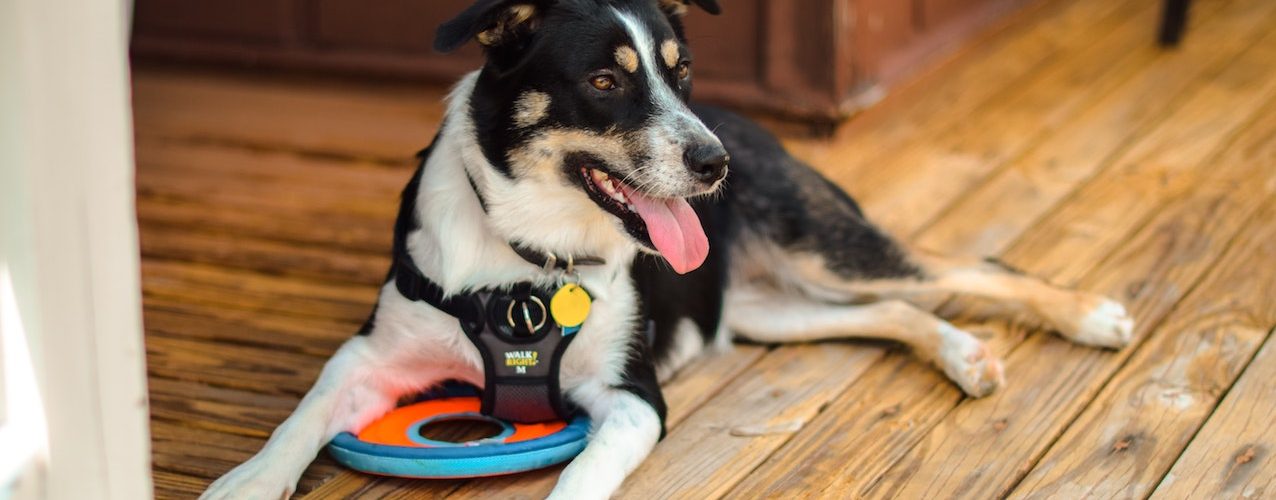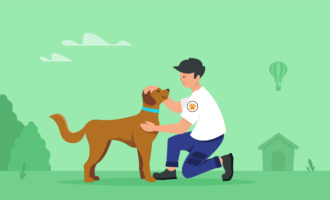Most people picture a service dog as a loyal Golden Retriever or German Shepherd sitting patiently at the feet of their humans, leading them across busy intersections and alerting them to impending danger.
The Americans with Disabilities Act (ADA) defines service animals as dogs “individually trained to do work or perform tasks for people with disabilities.” These are working animals with specialized training, not pets.
But the ADA doesn’t specify what breed of dog can be trained and certified as a service animal. It isn’t just purebred canines who we see wearing those distinctive vests. Animal shelters are full of loving, smart, and loyal dogs capable of being trained as service dogs.
Service dogs are specially trained to assist people with their specific needs. A guide dog for visually impaired people is trained to help their person safely cross streets, walk up and down stairs, and otherwise safely navigate through their environment. Service dogs for deaf people are trained to alert their owners to doorbells, oven timers, smoke alarms, a baby’s cry, and other common sounds we rely on in daily life. Mobility dogs help people who use wheelchairs or walking devices by opening automatic doors and retrieving objects.
Emergency Medical Response Dogs (EMRD), often called seizure alert dogs, are trained to detect subtle signs of an impending seizure and alert their human partner before the person themself realizes what’s about to happen.
In recent years, there has also been a rise in the use of psychiatric service dogs, particularly to assist veterans suffering post-traumatic stress disorder (PTSD). The dogs are trained to help in various ways, such as alerting their owner to symptomatic repetitive behaviors or reminding them to take their medication.
Shelter dogs are entirely capable of being trained as excellent service dogs in any of these specialties. It’s important to note that you can train the animal yourself. You don’t need to have the dog professionally trained to qualify as a service dog under the ADA.
Identifying the right shelter dog
Not every dog is capable of succeeding with service dog training. You can find the right dog at a shelter, but you need to take the time to determine which dog is a good fit. Some things to consider include
- The dog’s age. Puppies are cute, but they require much more training and supervision than an older dog. In addition, with an older dog, any medical problems the dog might have, such as allergies, will already have manifested so you’ll have a better idea of their health.
- The dog’s temperament. Quieter, more mature dogs focus better on a task and are easier to train than a bouncy, exuberant puppy. How does the dog react to petting, loud noises, or sudden movement? A dog that remains calm is a good candidate.
- The dog’s size. You’ll want a larger dog if you need help reaching higher shelves or if you have balance issues so the dog can brace you.
It’s important to spend time with the dog you’re considering to determine whether the animal can handle the training, perform repetitive tasks, is even-tempered, and is eager to please, which are important qualities for every service dog.
Training your shelter dog to be a service dog
Once you’ve brought home your shelter dog, the next step is to train the dog. Ideally, the dog will already be house-trained, but if not, you’ll need to work on foundational skills like eliminating on command in appropriate locations.
Resources like the American Kennel Club’s Canine Good Citizen program provide benchmarks for what your new dog should be able to do, including:
- Accepting a friendly stranger
- Sitting politely for petting
- Remaining calm during grooming
- Taking a walk on a leash
- Moving politely through a crowd
- Sitting and staying in place
- Coming when called
- Behaving politely around other dogs
- Staying focused
You need a dog capable of remaining focused on you regardless of distractions like other animals. Service dogs need to behave when they encounter other dogs.
Once you’ve taught your shelter dog the basics and socialized them, the next step is heeling, proofing, and tasking.
Heeling is a difficult command for some dogs to learn because it requires the dog to follow you, regardless of what you do, even if the dog isn’t on a leash.
Proofing is another essential skill that’s difficult and time-consuming to teach a dog. Proofing requires the dog to tune out all distractions. A service dog can’t lose focus because they see a discarded bagel remnant under a café table or a passing squirrel.
The dog has to be ready to serve. It’s a good practice to teach the dog a cue so that they know when they’re off duty and can play. For example, you could have a friend come over with a dog toy, and when the dog looks at the toy, use the word “play” to let the dog know it’s OK to keep going.
Tasking is actually the easiest skill to teach your service dog once they’ve mastered heeling and proofing.
What you teach your dog depends on the disability. If you’re hard of hearing, you’ll need to teach the dog to alert you to when an alarm goes off or a phone rings. If you need a service dog because of mobility issues, you’ll need to teach the dog to get your keys or your phone.
Teach your dog tasks incrementally, with sessions that last no more than five or 10 minutes at a time.
Once you’ve finished training your dog, you don’t actually have to register your dog as a service dog. The ADA doesn’t require it, and no legitimate registry requires you to pay to register your service animal. However, colleges and municipalities may offer a voluntary registry for those looking for animals in the event of an emergency or for a reduced dog licensing fee.
Consider buying a service dog vest for your animal. It’s not required, but it identifies the dog as a trained service animal.
Once your shelter dog’s transformation into a service dog is complete, go out and enjoy life with your new helper at your side.










Send Comment: